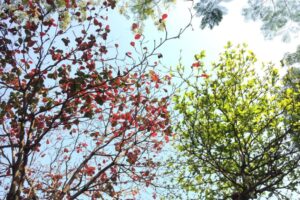
Dharma Byte
QUOTING MATSUOKA-ROSHI
By Taiun Michael Elliston-roshi
Atlanta Soto Zen Center (ASZC) and in our affiliate centers of the Silent Thunder Order (STO) are engaged in an effort to establish a dharma-oriented, collaborative community (S. sangha) in the context of our contemporary American culture. Nobody said it would be easy.
As part of this collaboration, in consulting with members of the online communications committee for the STO, I respond to suggestions for topics or content for my monthly Dharma Byte (DB). Hopefully, my comments will address some of the concerns that are top-of-mind for our readers.
As one of our key online members reminded us, there will be three newsletters between now and the 40th Anniversary of ASZC and our annual Precepts Retreat. She suggests three DBs on Matsuoka-roshi; STO; and the ASZC. A series building up to the conference/retreat/celebration in July; speaking to the past, future, and present of our lineage and legacy.
In line with this suggestion, the following will address the first concern, recalling some pertinent and peculiar teachings of Matsuoka-roshi, which may not be recorded elsewhere, but are part of my anecdotal recollection of this Old Buddha’s message. My commentary hopefully fills in some of the unknowns in his meaning. There is a lot more to say in each case, but I will keep it brief.
“Zen is always contemporary”
Sensei always railed at the attitude that Zen was some arcane, irrelevant idea in history, perhaps worthy of study, but not to be considered a vital and essential part of our contemporary reality and practice. His life was an example of the central and crucial practice of Zen, and zazen, for our time and place.
“You have to work your way through every bone in your body”
In following the practice of Zen, and its rigorous meditation, zazen, it is necessary to dedicate yourself unreservedly to immersion in direct experience. Often, this involves a significant degree of discomfort, on the physical level, as well as from mental and emotional distress. There are several hundred bones in the body, as well as an accompanying complement of muscles, tendons and ligaments, so this statement begs to be taken literally. But it is worth the effort.
“We teach each other Buddhism”
This statement is an elemental truth, but also a testament to Sensei’s humility, which is not personal, but a trait of Zen itself. It is also true that we do not necessarily teach each other equally, as in “all opinions are equal.” The Master’s teaching of Zen may be very different from the student’s teaching, but ultimately, all we are expressing is our understanding, however poor, of buddhadharma.
“Zazen is one straight line between heaven and earth (drop a coin through the top of your head: it will go straight through to the center of the earth)”
Sensei always emphasized the real-world, practical dimension of Zen practice, without undue speculation as to the physical reality, which is mostly beyond our ken. Nevertheless, coming into alignment with the forces or gravity, like a metal filing on a magnet, is clearly a major part of what makes zazen “work.”
“Grasping mind is like grasping incense smoke”
Sensei would often say that we cannot grasp Zen, any more than we can grasp the rising smoke of the burning incense on the altar. The more we try, the more the smoke tendrils evade our grasp. But when we stop trying, and open our hand, the incense smoke embraces our palm. This is our approach in Zen. We allow it to come to us, rather than pursuing it — the way we do most things.
“You and me — communication”
One day at the Zen Buddhist Temple of Chicago, on Halsted street just south of Fullerton on the near north side, we were cleaning (J. soji). At one point, Sensei and I had had some kind of verbal exchange, when, making a fist of his right hand, he touched his stomach and gestured toward mine, saying, “You and me – communication.” I took this to be some subliminal level of understanding that did not need to be explained, or explored further, but was simply a statement of fact. When we practice Zen together, we develop a kind of subliminal connection that does not rely upon, or need, verbal or conceptual clarification. It just is.
“Zen is not up for debate”
Sensei was not inclined to “suffer fools gladly,” as, we are given to understand, neither was Shakyamuni Buddha. He had a certain amount of sympathy for the Western or American seeker, as conditioned by their culture, but would cut off specious and speculative discourse with little sympathy. His main point was that if you did not come with an open mind, it is probably hopeless, and you should stop wasting your time, and his, with your futile efforts.
“Zen keeps the men younger, and the women more beautiful”
Sensei was a shameless promoter of Zen and zazen, as am I, and as was Master Dogen. But at the tender age of my mid-70’s, I have to admit that the first part of his proposition has some relevancy. I do not think that my current level of health and wellbeing, or my ability to put on my pants and socks without falling down, is not connected to decades of zazen and kinhin, the careful, balanced way of walking around the zendo, getting up and down from the floor, like a normal child spends most of their day. This is not so much a mystical statement of magical thinking, as it is a practical formula for methodical aging.
“Zen is something round and rolling, slippery and slick”
We all want to grasp the truth of Zen, and for very good reason. Without doing so, after all, we are forever cursed to ignorance and delusion. But, like a bar of wet soap, it slips out of our grasp, as soon as we try to capture it. Zen requires the surrender of such acquisitive attitudes. We cannot learn Zen; we have to unlearn everything else we think we know. What is left is Zen.
With Matsuoka-roshi, there are many more quotes to be remembered, and dissected as to their meaning and relevance to our life. We are collecting and documenting them as part of the Matsuoka Archive project, along with the video documentary of his origins in Japan, and coming to America in 1939. Above are but a sampling of appetizers, fondly recalled and recorded for you. I hope you will follow and read his published talks in “The Kyosaku” and “Mokurai,” both of which are available on our web sites. And that you will join and participate in our Fortieth Anniversary this year, by attending the retreat and conference in July. See you then and there.








